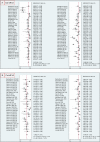The accuracy of Vesical Imaging-Reporting and Data System (VI-RADS): an updated comprehensive multi-institutional, multi-readers systematic review and meta-analysis from diagnostic evidence into future clinical recommendations
- PMID: 35294583
- PMCID: PMC9237003
- DOI: 10.1007/s00345-022-03969-6
The accuracy of Vesical Imaging-Reporting and Data System (VI-RADS): an updated comprehensive multi-institutional, multi-readers systematic review and meta-analysis from diagnostic evidence into future clinical recommendations
Abstract
Purpose: To determine through a comprehensive systematic review and meta-analysis the cumulative diagnostic performance of vesical imaging-reporting and data system (VIRADS) to predict preoperative muscle-invasiveness among different institutions, readers, and optimal scoring accuracy thresholds.
Methods: PubMed, Cochrane and Embase were searched from inception up to May 2021. Sensitivity (Sn), Specificity (Sp) were first estimated and subsequently pooled using hierarchical summary receiver operating characteristics (HSROC) modeling for both cut-off ≥ 3 and ≥ 4 to predict muscle-invasive bladder cancer (MIBC). Further sensitivity analysis, subgroup analysis and meta-regression were conducted to investigate contribution of moderators to heterogeneity.
Results: In total, n = 20 studies from 2019 to 2021 with n = 2477 patients by n = 53 genitourinary radiologists met the inclusion criteria. Pooled weighted Sn and Sp were 0.87 (95% CI 0.82-0.91) and 0.86 (95% CI 0.80-0.90) for cut-off ≥ 3 while 0.78 (95% CI 0.74-0.81) and 0.94 (95% CI 0.91-0.96) for cut-off ≥ 4. The area under the HSROC curve was 0.93 (95% CI 0.90-0.95) and 0.91 (95% CI 0.88-0.93) for cut-off ≥ 3 and ≥ 4, respectively. Meta-regression analyses showed no influence of clinical characteristics nor cumulative reader's experience while study design and radiological characteristics were found to influence the estimated outcome.
Conclusion: We demonstrated excellent worldwide diagnostic performance of VI-RADS to determine pre-trans urethral resection of bladder tumor (TURBT) staging. Our findings corroborate wide reliability of VI-RADS accuracy also between different centers with varying experience underling the importance that standardization and reproducibility of VI-RADS may confer to multiparametric magnetic resonance imaging (mpMRI) for preoperative BCa discrimination.
Keywords: Bladder cancer; Bladder cancer staging; Multiparametric magnetic resonance imaging; Muscle-invasive bladder cancer.
© 2022. The Author(s).
Conflict of interest statement
Regarding the content of this paper, the authors declare that they have no conflict of interest to disclose.
Figures



References
-
- Del Giudice F, Campa R, Bicchetti M, De Berardinis E, Panebianco V. Vesical imaging-reporting and data system (VI-RADS) incorporated into bladder cancer clinical practice: what's the perspectives beyond diagnostic accuracy? Transl Androl Urol. 2020;9(5):2320–2322. doi: 10.21037/tau-2020-07. - DOI - PMC - PubMed
-
- Panebianco V, Narumi Y, Altun E, Bochner BH, Efstathiou JA, Hafeez S, Huddart R, Kennish S, Lerner S, Montironi R, Muglia VF, Salomon G, Thomas S, Vargas HA, Witjes JA, Takeuchi M, Barentsz J, Catto JWF. Multiparametric Magnetic Resonance Imaging for Bladder Cancer: Development of VI-RADS (Vesical Imaging-Reporting And Data System) Eur Urol. 2018;74(3):294–306. doi: 10.1016/j.eururo.2018.04.029. - DOI - PMC - PubMed
-
- Woo S, Panebianco V, Narumi Y, Del Giudice F, Muglia VF, Takeuchi M, Ghafoor S, Bochner BH, Goh AC, Hricak H, Catto JWF, Vargas HA. Diagnostic performance of vesical imaging reporting and data system for the prediction of muscle-invasive bladder cancer: a systematic review and meta-analysis. Eur Urol Oncol. 2020;3(3):306–315. doi: 10.1016/j.euo.2020.02.007. - DOI - PMC - PubMed
Publication types
MeSH terms
LinkOut - more resources
Full Text Sources
Medical
Miscellaneous

